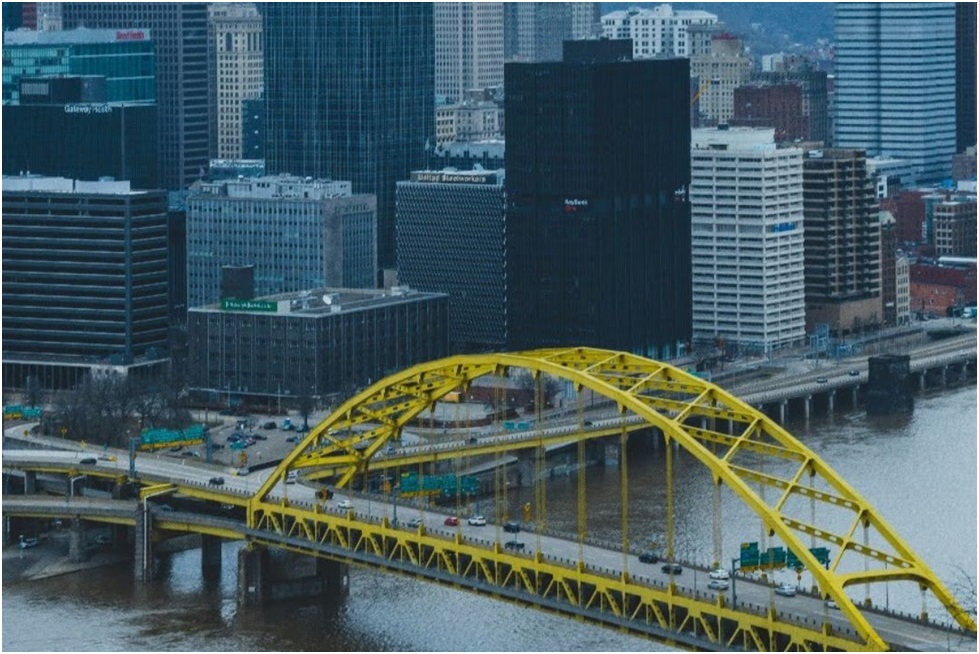
Key Takeaways
- Neighborhood Rental Price Variation: Pittsburgh’s rental prices vary by neighborhood. Areas like Downtown and Shadyside cost more due to their proximity to amenities, while Greenfield and Brookline offer more affordable options.
- Current Average Rent In Pittsburgh: Pittsburgh remains affordable compared to larger cities, with one-bedroom apartments averaging $1,200 and two-bedrooms around $1,500, depending on location and amenities.
- Rental Price Trends For the Coming Year: Rental prices are expected to rise 2% to 4% in the coming year, driven by steady economic growth, increased demand, and changing preferences due to remote work.
Average Rent In Pittsburgh: What To Expect This Year And Next
Our unparalleled expertise in multiple markets and a solid local presence in Pittsburgh uniquely position us to offer predictions and guidance grounded in exceptional service and local knowledge. Our commitment is to provide you with the most up-to-date and comprehensive insights into what you can expect from the average rent in Pittsburgh this year and next.
In Pittsburgh's housing market, understanding the fluctuations and trends in average rent is essential for both renters and buyers navigating their living options. The Steel City, renowned for its rich history, burgeoning tech scene, and vibrant cultural tapestry, has witnessed significant shifts in its real estate dynamics, influenced by economic factors, population growth, and evolving consumer preferences.
In this article, we will explore the current average rent in Pittsburgh, the factors influencing rental prices across various neighborhoods, and the projected trends for the upcoming year, helping you make informed decisions in this dynamic market.
Understanding Pittsburgh's Geographic Rental Variations
Pittsburgh comprises numerous neighborhoods, each with unique characteristics and rental market dynamics. Renters and buyers must understand these geographic variations to navigate the rental terrain effectively, as they play a critical role in influencing rental prices across the city.
High-Rent Areas
The city's geography significantly affects rental costs, from riverfront properties to bustling downtown high-rises. Neighborhoods such as Downtown Pittsburgh, Shadyside, and Lawrenceville are known for their higher-than-average rents due to their proximity to major employment hubs, recreational parks, and various amenities. These areas offer a rich array of living experiences but come with a premium price tag, reflecting their desirability and the high demand for rentals in these locales.
Affordable Alternatives
Conversely, neighborhoods like Greenfield or Brookline present more affordable renting options without compromising access to Pittsburgh's vibrant lifestyle. These areas may not boast the same proximity to downtown or waterfront views, but they offer a more cost-effective entry point into the Pittsburgh rental market. They are perfect for individuals and families looking for quieter, community-oriented neighborhoods.
Balancing Lifestyle And Budget
Understanding these geographic rental variations is crucial for renters and buyers to find the best fit for their lifestyles and budgets. Pittsburgh's rental market offers something for everyone, from luxury downtown apartments to affordable suburban homes.
Current Average Rent In Pittsburgh: A Snapshot
Investing in Pittsburgh's dynamic real estate market needs a clear understanding of the current rental landscape. The city, known for its rich history, vibrant neighborhoods, and thriving business ecosystem, offers various rental options catering to diverse preferences and budgets.
This section presents a comprehensive snapshot of the current average rent in Pittsburgh:
Average Rent For One- And Two-Bedroom Apartments
As of this year, the average rent in Pittsburgh has shown exciting trends that are vital for potential renters and investors to consider. Renters can expect to pay around $1,200 monthly for a one-bedroom apartment. This figure, of course, can vary significantly depending on the neighborhood, with areas closer to downtown or with higher demand witnessing higher rental prices. Two-bedroom apartments have seen a similar trend, with the average rent hovering around $1,500 monthly.
Luxury Living And Upscale Rental Options
The rental market in Pittsburgh also shows variation when considering luxury apartments and amenities. For those seeking higher-end living spaces, the average rent can escalate to $2,000 or more per month, especially in upscale neighborhoods or newer developments equipped with modern facilities such as fitness centers, rooftop terraces, and smart home technology.
Factors Affecting Rental Prices In Pittsburgh
When analyzing the average rent in Pittsburgh, several key factors are pivotal in determining the rental prices. Understanding these can help renters and buyers make informed decisions. HomeRiver Group is deeply familiar with these factors and how they uniquely affect the Pittsburgh market as an organization that prides itself on offering exceptional service with local expertise.
Economic Growth And Job Market
Pittsburgh's economy, characterized by its steady growth and diversification beyond its historical steel roots, significantly impacts rental prices. The emergence of tech, medicine, and education as dominant sectors in the local economy has attracted a workforce from various backgrounds and skill sets. This influx of professionals increases the demand for housing, pushing rental prices upward, especially in areas close to major employment centers.
Location And Neighborhood Amenities
Pittsburgh's location substantially influences rental rates. Neighborhoods offering convenient access to public transportation, top-rated schools, parks, and other amenities typically command higher rents. The desirability of living in vibrant areas such as Shadyside or Lawrenceville, known for their lively dining and shopping scenes, reflects the premium renters are willing to pay to inhabit these neighborhoods.
Real Estate Market Trends
Pittsburgh's real estate market exhibits trends that directly impact rental prices. The supply and demand for rental properties, influenced by new construction developments and the conversion of commercial spaces into residential units, play a critical role. In times of high demand and low supply, rent prices trend upward and vice versa. Keeping an eye on these market dynamics is essential for potential renters and buyers.
Seasonal Variations
The time of year can also affect rental prices in Pittsburgh. Generally, the rental market sees increased activity during the summer months, coinciding with the end of the academic year and the most popular time for moving. This heightened demand can lead to competition over available units and potentially higher rental prices. Conversely, renters may find better deals during winter when the market cools.
Projected Rent Trends For The Upcoming Year
As we look toward the upcoming year, understanding the projected trends in the average rent in Pittsburgh is critical for both renters and buyers. The insights provided here draw from the latest market analysis and the expertise of HomeRiver Group, ensuring a comprehensive outlook on what to expect.
Post-Pandemic Stabilization And Market Growth
The pandemic's aftermath continues to ripple through the housing market, influencing rent prices nationwide. However, Pittsburgh's market is showing signs of stabilization. The average rent in Pittsburgh is projected to increase moderately for the upcoming year. Factors contributing to this forecast include a growing demand for rental properties driven by an influx of professionals and students to the city and a relatively slow pace of new construction projects.
Expected Rent Increases: What Renters Can Anticipate
Specifically, renters in Pittsburgh can anticipate an approximate 2% to 4% increase in rent prices across most neighborhoods. This projection aligns with the expected national average increase, suggesting that Pittsburgh's market is moving with broader national trends.
Neighborhood-Specific Trends
High-demand areas such as Downtown Pittsburgh, Shadyside, and Lawrenceville may experience higher increases due to their popular locations and the premium amenities often available in these neighborhoods. On the other hand, more suburban areas could see a more modest increase, making them attractive options for those looking to find more budget-friendly accommodations without venturing too far from the city's heart.
The Impact of Remote Work On Rental Demand
It's also important to note the impact of remote work trends on the rental market. As more employers adopt flexible working policies, areas outside the immediate vicinity of business districts might see a rise in demand, potentially affecting rent prices even in these traditionally less expensive neighborhoods.
The Most Affordable Neighborhoods In Pittsburgh
Understanding the most affordable neighborhoods becomes crucial for renters and buyers looking to maximize value without compromising the quality of life when navigating the average rent landscape in Pittsburgh.
HomeRiver Group, with its unmatched local expertise, highlights several neighborhoods that stand out for their affordability and appeal:
- Brookline: Known for its tight-knit community and vibrant main street, Brookline offers a suburban feel with the convenience of city living. The average rent here remains below the city’s median, making it an attractive option for those looking to balance affordability and accessibility to downtown amenities.
- Beechview: With easy access to the T (Pittsburgh's light rail system), Beechview is perfect for commuters. The neighborhood boasts diverse dining and shopping options and affordable rental prices that appeal to a wide demographic, from students to young professionals and families.
- Carrick: Offering a range of rental options from single-family homes to apartments, Carrick is recognized for its affordability and a sense of community. Its convenient location and direct bus routes to downtown make it ideal for renters looking for budget-friendly living outside the city center.
- Greenfield: If you're seeking a balance between nature and urban living, Greenfield’s average rent and scenic views of the Monongahela River offer an appealing compromise. With both parks and a growing commercial district, it represents an opportunity for affordable housing without sacrificing the perks of city life.
- Sheraden: A neighborhood quickly gaining attention for its affordable housing market, Sheraden offers spacious homes at competitive rental rates. Its proximity to major highways and downtown Pittsburgh, combined with the community’s investment in local parks and schools, makes it a strategic choice for those prioritizing both price and quality of life.
Final Thoughts
Understanding the average rent in Pittsburgh is crucial for renters and buyers to make informed decisions in this dynamic market. As we look towards this year and next, it's evident that Pittsburgh's rental landscape is evolving. Economic shifts, demographic trends, and local developments play a significant role in shaping rental prices.
However, HomeRiver Group offers exceptional service and local expertise amidst these fluctuations. Our comprehensive understanding of the Pittsburgh market, combined with our national platform, positions us uniquely to provide unparalleled value to our clients. We are committed to ensuring that your property journey in Pittsburgh is seamless and rewarding, keeping your priorities at the forefront of our operations.
With HomeRiver Group, you're securing a future in one of the most vibrant cities, backed by a team that truly cares about turning your property goals into reality.
Read also:
- The Ultimate Guide To Property Management In Pittsburgh
- Top Leasing Trends In Single-Family Residences
- Property Management Services
Frequently Asked Questions About Average Rent In Pittsburgh
What factors influence the average rent in Pittsburgh?
Location, property size, demand, and the city's economy are key factors. Proximity to employment hubs, universities, public transit, and amenities also impact rental prices, along with building quality and included amenities.
What neighborhoods in Pittsburgh have the highest average rent?
Downtown, Shadyside, Squirrel Hill and Lawrenceville have the highest rents due to their luxury apartments, amenities, and proximity to employers and nightlife.
How does Pittsburgh's cost of living compare to other cities?
Pittsburgh’s cost of living is lower than that of many major U.S. cities, especially in terms of housing. Rent is below the national average, though factors like utilities and transport can vary.
What neighborhoods in Pittsburgh offer more affordable rental options?
Greenfield, Bloomfield, and parts of the South Side offer more affordable rents with good access to amenities and public transit, which is popular among students and young professionals.
What are the predictions for rent prices in Pittsburgh next year?
Rent is expected to rise gradually but remains affordable compared to other cities. Market demand, economic factors, and new developments will shape future pricing.
How does the average rent in Pittsburgh vary by apartment size?
Rent varies by apartment size, with studios and one-bedrooms cheaper. Larger units cost more, and location can significantly influence prices. A one-bedroom in Shadyside could match a larger unit in a less central area.










